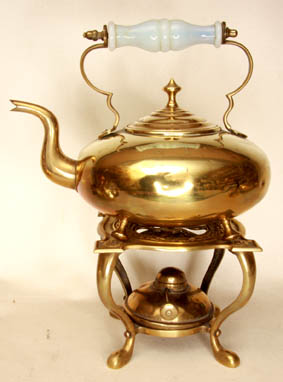James Clews Family
(c) Antique Metalware Society
Small extracts can be used with acknowledgements to 'Oldcopper.org' website.
Helpful comments are very welcome.
Some of the Clews Family of Birmingham
1835 Samuel Clews, brass tea kettle and knocker manufacturer, 6, Court, Oxford Street, 1835
1835 Joseph Clews 14, Moland Street, 1835 Brass candlestick maker
1896 Frederick & Richard Clews, 104, Moland St., brass founders.
1922 F & H Clews 105, Moland Street, bucklemakers, taken over by Pearson Page Jewsbury in the 1930s.
1922 Allen James Clews, 101, Moland Street, Birmingham and 194 & 195, Aston Road, (1922). By 1943 they were at Waterloo Metal Works, Lewisham Rd., candlesticks, bells, etc. Not found after 1948.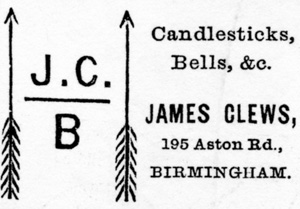
Clews, James Clews (JC/B mark), 101, Moland Street, Birmingham then Manilla Works, 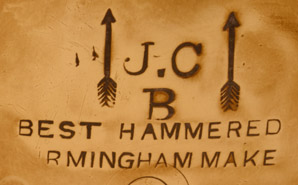 195, Aston Road, Birmingham, then Waterloo Metal Works, Lewisham Road, Birmingham by 1943. The family made kettles, candlesticks, bells, etc. from before 1835 until c1948.
195, Aston Road, Birmingham, then Waterloo Metal Works, Lewisham Road, Birmingham by 1943. The family made kettles, candlesticks, bells, etc. from before 1835 until c1948.
A mark still clear on the base of a spirit kettle. The 'B' stands for Birmingham, as for some other manufacturers. The factory survived the blitz but is not found in the directories after 1948.
Clews were manufacturers of the 'Diamond' range including Ace, King and Queen made to celebrate the Diamond Jubilee of Queen Victoria. Later they produced the Prince and Princess of Diamonds range. Diamond Candlesticks page.
- and this mark on the base of good candlesticks of the beehive and diamond design.
'Scottish' Toddy Kettles
Real and Replicas
This is a term used to describe kettles of ovoid shape standing on three or four feet that could be used to hold hot water to be added carefully to a spirit such as whiskey to make 'Hot Toddy' . They are usually made of brass and seem to have been produced mainly in Birmingham for markets in Scotland and world wide.
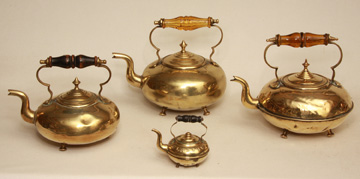
This group of toddy kettles includes two good quality kettles made by Clews (left and top), one unmarked (right) and a miniature marked 'A present from Glasgow' that was made by Samuel Heath & Co., Birmingham.


Here the top photo shows the smoothly brazed butt joint of a genuine Clews kettle while the lower one shows a lapped joint with impressed beading on the unmarked kettle.
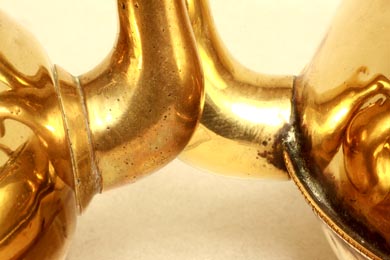
The Clews kettles have their spouts securely soldered to a spigot raised on the kettle body while the unmarked one has the spout inserted and soldered directly to the body.
